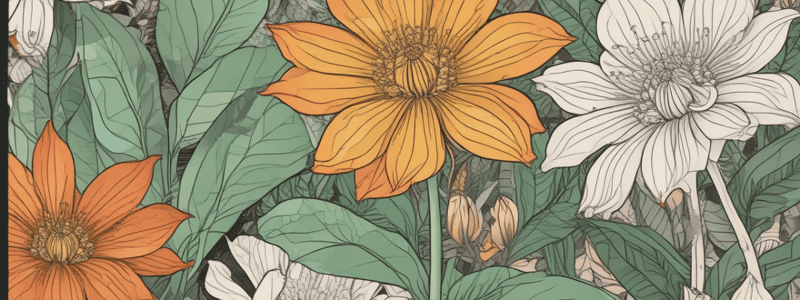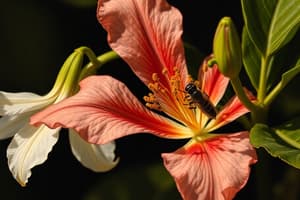Podcast
Questions and Answers
What is the primary function of the filament in a flower?
What is the primary function of the filament in a flower?
- To attract pollinators with fragrance
- To absorb sunlight for photosynthesis
- To transport nutrients to the ovules
- To hold the anther in place (correct)
Which statement best describes cross-pollination?
Which statement best describes cross-pollination?
- It occurs within the same flower's reproductive structures.
- It involves pollen moving from an anther to the stigma of a different plant of the same species. (correct)
- It is the transfer of pollen between flowers of different species.
- It occurs entirely without the involvement of pollinators.
During pollen development, what process do microspore mother cells undergo?
During pollen development, what process do microspore mother cells undergo?
- Mitosis to produce diploid cells
- Photosynthesis for energy
- Fertilization to create a zygote
- Meiosis to yield a tetrad of haploid cells (correct)
What are the two nuclei derived from a pollen grain after dividing by mitosis?
What are the two nuclei derived from a pollen grain after dividing by mitosis?
What term is used to define the fusion of male and female gametes to create a zygote?
What term is used to define the fusion of male and female gametes to create a zygote?
Which of the following best describes the adaptation of a wind-pollinated plant?
Which of the following best describes the adaptation of a wind-pollinated plant?
What is dormancy in the context of seeds?
What is dormancy in the context of seeds?
Which of the following is NOT an advantage of seed dispersal?
Which of the following is NOT an advantage of seed dispersal?
What factors are essential for successful germination of seeds?
What factors are essential for successful germination of seeds?
Flashcards are hidden until you start studying
Study Notes
Functions of Flower Structures
- Sepals protect the flower, providing support and defense against external threats.
- Petals attract insects for pollination through bright colors and appealing shapes.
- Stamens produce pollen grains, essential for fertilization.
- Anthers are the structures on stamens that generate and release pollen.
- Filaments are stalk-like components that hold the anther in position.
Reproductive Structures
- Carpels are responsible for producing ovules, which develop into seeds after fertilization.
- Stigmas serve as landing sites for pollen during the pollination process.
- Styles are tubes facilitating the movement of pollen from the stigma to the ovary.
Pollen Development
- Microspore mother cells undergo meiosis, resulting in a tetrad of haploid cells.
- Pollen grains divide by mitosis to form two haploid nuclei: a tube nucleus and a generative nucleus.
Pollination Types
- Pollination involves transferring pollen from an anther to the stigma of the same species’ flower.
- Self-pollination occurs when pollen from an anther lands on the stigma of the same plant.
- Cross-pollination is the transfer of pollen to the stigma of a different plant within the same species.
Pollination Methods
- Insect pollination and wind pollination are two main methods facilitating this process.
- Insect-pollinated plants often have brightly-colored petals and sticky pollen to attract and retain insects.
- Wind-pollinated plants typically feature light, dry pollen and long, feathery stigmas to capture airborne pollen.
Fertilization and Zygote Formation
- Fertilization is the fusion of male (n) and female (n) gametes, leading to the formation of a zygote (2n).
Dormancy
- Dormancy is a resting phase of minimal metabolic activity, allowing plant embryos time to develop.
- An advantage of dormancy includes allowing embryos the necessary time for maturation before germination.
Seed Dispersal
- Dispersal methods include wind and animals, enabling plants to colonize new areas and reduce competition for resources.
- An advantage of dispersal is the potential for species expansion into unoccupied habitats.
Germination Process
- Germination marks the process where the embryo develops into a new plant, contingent on suitable conditions.
- Essential factors for successful germination include access to water and the right temperature.
Studying That Suits You
Use AI to generate personalized quizzes and flashcards to suit your learning preferences.




